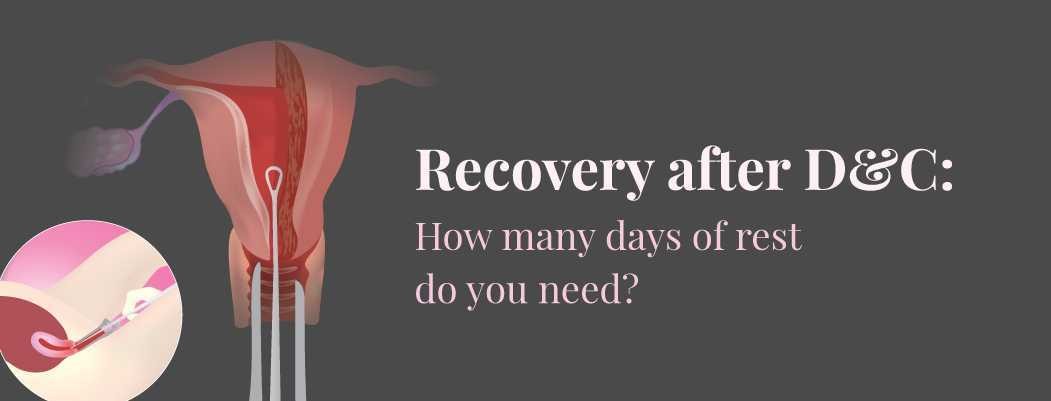How many days rest after D&C
February 7, 2023

Dilation and curettage (D&C) is a medical procedure to remove tissue from the uterus. The procedure involves dilating the cervix and scraping the uterine lining with a curette. A D&C is usually done for various reasons, including diagnosing and treating certain medical conditions. In this blog, we will discuss the reasons for a D&C, what to expect when having a D&C, the uses of D&C, and when to seek help.
Contents
Reasons for a D&C
There are several reasons why a woman may need to have a D&C. Some of the common reasons include the following:
- Miscarriage: A D&C may be needed if a woman has had a miscarriage and some tissue is left in the uterus.
- Abnormal uterine bleeding: A D&C may be performed to diagnose and treat abnormal uterine bleeding. Hormonal imbalances, fibroids, or polyps can cause this.
- Endometrial hyperplasia: This is a condition with an overgrowth of cells in the uterine lining. A D&C may be done to remove the excess tissue and reduce the risk of developing cancer.
- Uterine cancer: If uterine cancer is suspected, a D&C may be done to collect tissue samples for examination.
- Incomplete abortion: If a medical abortion (using pills) has failed or an incomplete abortion occurs, a D&C may be required.
What to Expect When Having a D&C?
A D&C is usually done under general anaesthesia or local anaesthesia with sedation. The procedure itself typically takes around 10-15 minutes. The doctor will dilate the cervix during the procedure to allow uterine access. They will then use a curette to scrape the uterine lining and remove any tissue. After the procedure, the woman may experience cramping, spotting, and light bleeding. Pain relief medications may be prescribed as needed.
Uses of D&C
Apart from the reasons mentioned above, D&C is also used for other medical purposes, such as:
- Diagnosis of infertility: A D&C may be done to diagnose the cause of infertility. This may include removing tissue for examination and testing.
- Removal of uterine polyps: If a woman has uterine polyps, a D&C may be performed to remove them.
- Treatment of heavy periods: A D&C may be done to remove excess tissue in the uterus, which can reduce heavy menstrual bleeding.
- Management of postpartum bleeding: A D&C may be necessary to manage heavy bleeding after delivery.
How long does it take to recover from D and C?
The recovery time for a D&C (dilation and curettage) procedure can vary depending on the individual and the reason for the procedure. The recovery period typically lasts 1-2 weeks, although some women may take longer to recover fully.
During the first few days after the procedure, it is common to experience mild to moderate cramping, spotting, and light bleeding. Pain relief medications may be prescribed to manage any discomfort. It is important to avoid strenuous physical activity, heavy lifting, and sexual activity during this time to allow the body to heal properly.
After the initial recovery period, it is common to experience some light bleeding and spotting for up to a week or two. Women may also experience some irregular periods in the following weeks or months.
Following the healthcare provider’s post-procedure instructions and attending any follow-up appointments as required is essential. This may include scheduling a follow-up visit to ensure the procedure succeeded and monitoring potential complications.
Physical recovery
A D and C’s physical recovery takes little time. If someone has had anaesthesia, they might feel drowsy. But this should go away in a day or two. As soon as they feel ready, they can resume most of their regular tasks when they feel ready.
Following a D&C procedure, certain activities should be avoided for one week, including swimming, using tampons or other vaginal objects, and sexual intercourse. In addition, showers are allowed for hygiene purposes during this time. It is common to experience mild pain, cramping, and light bleeding, similar to 14 days after the procedure. Therefore, it is essential to attend a follow-up appointment with a doctor 14 days after the procedure and to report any ongoing symptoms, such as prolonged bleeding or pain.
Emotional recovery
The emotional recovery from a D&C procedure can vary among individuals, with some experiencing no lasting effects. Although, in a study conducted in 2020, most individuals who had undergone an abortion still believed it was the right decision five years later and reported feeling relieved, how someone feels after a D&C procedure depends on factors surrounding their decision, such as the difficulty of making the decision and the stigma of others. Whether a person wanted the pregnancy or not also affects their emotional response; for example, those who have lost a desired pregnancy may feel intense grief. Individuals who had to terminate a pregnancy due to health risks may experience stress, anxiety, or depression. There is no right or wrong way to feel after a D&C procedure. Still, those who anticipate difficulty coping may find it helpful to take time off work, engage in low-energy activities such as watching movies, and spend time with supportive friends or family. Individuals who experience ongoing emotional distress may consider seeking the help of a therapist.
When to seek help?
After a D&C, a woman may experience some cramping, spotting, and light bleeding. However, if any of the following symptoms occur, she should seek medical help immediately:
- Heavy bleeding: If the woman is soaking through more than one pad per hour, this may indicate a problem, and medical attention should be sought.
- Severe pain: If the woman experiences severe pain not relieved by painkillers, medical attention should be sought.
- Fever: If the woman develops a fever after the procedure, she should seek medical help as this may indicate an infection.
- Foul-smelling discharge: If the woman experiences a foul-smelling discharge after the procedure, she should seek medical help, as this may also indicate an infection.
Who to consult for D&C?
Suppose you are considering a D&C procedure or have undergone one and have concerns. In that case, it is recommended that you consult with a gynaecologist or obstetrician who can provide you with personalised medical advice and guidance based on your health needs.
People also ask
How long do you have to be off work after a D&C?
The recovery time after a D&C (dilation and curettage) procedure can vary depending on individual circumstances and the reason for the procedure. Most women can generally return to work within a few days to a week after the procedure. However, your doctor will provide specific guidance on when it’s safe for you to resume work and other activities.
What are Do’s and Don’ts after D&C?
After a D&C procedure, following your doctor’s instructions is essential for a smooth recovery. Some do’s and don’ts after a D&C may include:
Do
- Rest and take it easy for a few days
- Use sanitary pads instead of tampons
- Stay hydrated and drink plenty of fluids
- Take pain medication as prescribed
- Contact your doctor if you experience heavy bleeding or other concerning symptoms
Don’t
- Have intercourse for at least two weeks after the procedure or until your doctor gives you the go-ahead
- Use any products in the vagina such as douches, tampons, or menstrual cups
- Engage in strenuous activities or heavy lifting
- Consume alcohol or smoke
Is a D&C considered a surgery?
Yes, a D&C (dilation and curettage) is considered a surgical procedure. It involves dilating the cervix and scraping the uterine lining to remove tissue. It may be performed under local or general anesthesia in an outpatient or hospital setting.
How many days do you bleed after a D&C?
The amount and duration of bleeding after a D&C procedure can vary depending on individual factors and the reason for the procedure. In general, most women experience light to moderate bleeding or spotting for a few days to a week after the procedure. However, it’s not uncommon to experience some degree of bleeding or spotting for up to two weeks after a D&C. Your doctor will provide specific guidance on what to expect and when to contact them if you experience heavy bleeding or other concerning symptoms.








